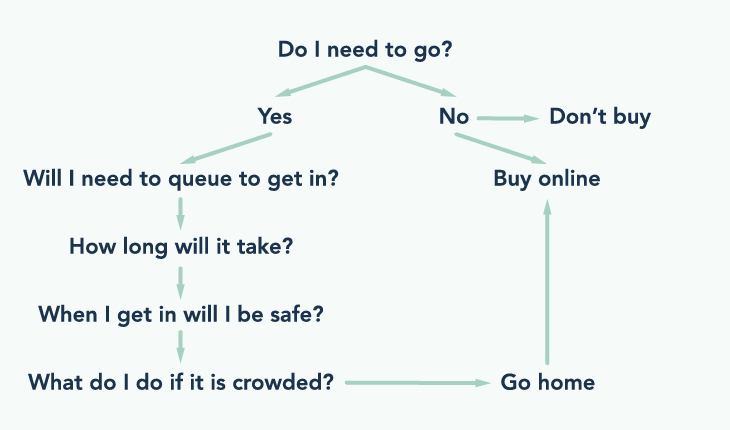With the UK government indicating that a phased opening of non-essential retail can potentially start from June the 1st. They’ve issued their guidance document for working in shops and branches.
What are shoppers going to be greeted with to deal with the requirements of maintaining the social distancing measures?
Only last week I saw images from a US retailer who's store was crammed full of shoppers - an image that during Black Friday would be welcomed, but now should petrify every one of us.
Shop owners, retailers and shopping centre owners need to be placing their customers at the centre of their thinking when planning their operational procedures and their external communication. Going shopping is now an uncertain past time.

The current customer mindset follows some simple questions and reasoning – starting with “Do I need to go?”.
This of course is not a linear thought process but the alternative to physical shopping is to get whatever you need in online and wait. Which is what most people have been doing now for two months.
Are the heady days of just going for a browse around the shop over?
Is the world where impulse purchasing has arguably gone now that "going to the shops" is a more complex decision and process?
So why will people go back and what is the opportunity for retailers and shopping centre owners?
Human nature suggests that shoppers will attempt to go back to their norm as soon as they can as habits take a long time to change. But C-19 may have changed this due to the lockdown and now the severe restrictions imposed to maintain social distancing. And how long will these restrictions be in place? [No one knows].
Westfield and Landsec have announced that they are getting ready for reopening. Their package of measures includes heightened cleaning, one-way systems where needed, monitoring live footfall cameras to manage the amount of people entering, floor stickers to mark social distancing spaces and every other car park space will be out of use. In addition to these measures hand sanitiser points will be put in place, security and concierge teams will be helping with queue management.
Is this enough? What are the retailers doing?
Looking at the latest information from the BBC about M&S and Next, it would appear that the plan is a combination of screens at tills, hand sanitisers and people management systems. One analyst has gone as far as saying that customers will be encouraged to avoid touching merchandise to reduce the risk of spreading the C-19 infection. It also looks like the large retailers will be hitting the discount button quite hard as they are sitting on excess Spring stock.
I've not seen much written about choking footfall in to shopping centres or stores, but this is inevitable and will surely mean that footfall will be limited to 10-20% of the normal levels. Which is an issue for all involved.
So it looks like a perfect storm is about to hit retail when it needs profit the most. Restricted customer numbers, potentially higher costs of operations, reduced services and deep discounts - all a drag on the bottom line. This doesn’t build to a better customer experience or a better business. Retailers need to accept that chasing sales isn't the only thing that is important to a brand right now, looking after their customers is.
What's the answer?
Is this the opportunity to finally tackle the elephant in room? The elephant being the poor, disconnected and impersonal shopping experiences that many of the large retailers offered prior to C-19. Over the past 5 years retailers have been filling up their space with more stock and in doing so reducing the opportunity for a great customer experience. At the same time they have employed less customer service staff per square foot to help customers. Self-service has been the direction of travel, with a few small exceptions. This has slowly eroded emotional loyalty to physical retail and promoted online purchasing as the go-to for many.
Retail brands need to review their core proposition and weigh up their hard and soft benefits. Hard benefits like discounts are likely to be secondary in the new-norm physical environment, giving way to the softer benefits of personalised experience and basic safety. The mission has to be to create, curate and invest in making the experience the best it can be within the restrictions. With less people in the stores the opportunity is to sell each customer more than a pre C-19 customer, their experience should be better as there are less crowds and in theory more staff per customer to help. The discount platform needs to encourage transaction value, not low value single purchases. Each touchpoint in the customer journey needs to be brand engineered to delight the customer - a great experience in the new norm will definitely be shared; as will a terrible one.
Creating a great customer experience in these testing times doesn’t solve the other [larger] elephant in the room - the retail business model elephant. The cocktail of less people in centres & stores, old fixed rent models, service charges and local rates doesn’t add up in a property climate that was already crumbling under its own stoic traditional approaches. Only the strong healthy brands will surely survive.
Now is the time for the brands to demonstrate that they are customer centric, that they understand their customers. For shopping centre owners this also means pivoting to a new business model with their retail tenants. This will drive brand advocacy at a shopper level, which drives the bottom line for all.
A return to retail is imminent - but not as we knew it.